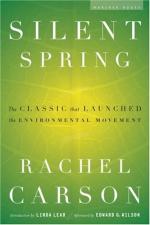
|
| Name: _________________________ | Period: ___________________ |
This test consists of 15 multiple choice questions and 5 short answer questions.
Multiple Choice Questions
1. What was the source of the contamination in the eagle population?
(a) Trees
(b) Other birds
(c) Fish
(d) Nests
2. Wildlife is unlikely to bounce back after _________ that kill large numbers of their kind.
(a) Temperatures
(b) Sprayings
(c) Fires
(d) Weather patterns
3. _____________ hurts the soil on a virtually permanent basis, according to Carson.
(a) Wild orange oil
(b) DDT
(c) Corn crops
(d) Arsenic
4. Continued use of pesticides could very well damage soil ___________.
(a) Illegally
(b) In some areas
(c) Over time
(d) Beyond repair
5. Large-scale, single-crop farming eliminates the _______________ that provided built in control of pests.
(a) Biodiversity
(b) Regulation
(c) Chemicals
(d) Possibility
6. The town Carson describes _________ actually exist.
(a) Will
(b) Does not
(c) Can
(d) Does
7. Chemicals can travel down ___________ or in underground aquifers to the bodies of water.
(a) Sewers
(b) Watersheds
(c) Streets
(d) Mountains
8. DDT is passed long through the ___________ during the course of nearly everyone's life.
(a) Packaged foods
(b) Air
(c) Food chain
(d) Exhaust fumes
9. Who has poisoned the entire environment, according to Carson as she will prove in this book?
(a) Insects
(b) Plants
(c) Animals
(d) People
10. Where was the population of Japanese Beetles effectively controlled?
(a) West
(b) North
(c) East
(d) South
11. What is the most important earth-dwelling creature, according to Carson?
(a) Earthworm
(b) Mouse
(c) Mole
(d) Millipede
12. Bacteria, fungi, and algae are the smallest organisms of Earth and they live in the ________.
(a) Air
(b) Water
(c) Stones
(d) Soil
13. Humans hold a narrow view of _________, using them when they are immediately useful only.
(a) Trees
(b) Plants
(c) Pests
(d) Animals
14. Throughout earth's history, living things have __________ with their environment but not changed it.
(a) Tinkered
(b) Grown
(c) Battled
(d) Interacted
15. All of the Earth's watersystems are _____________, so contamination of a part is contamination of the whole.
(a) At risk
(b) Separate
(c) Dirty
(d) Connected
Short Answer Questions
1. Humans __________ plants when an an immediate use is not obvious for a plant.
2. Studies on the __________ in areas previously sprayed with DDT have confirmed that DDT remains in the birds at least one generation after the spraying.
3. What are so popular that tourists come to see them every year?
4. Only _________ have gained the ability to reserve the roles and actually change the environment they live in.
5. What is the name of the naturally occurring mineral that is toxic to humans and most creatures but is still used as a pesticide?
|
This section contains 370 words (approx. 2 pages at 300 words per page) |

|




